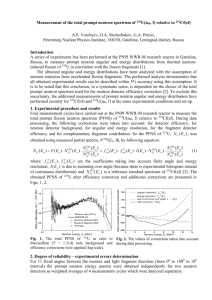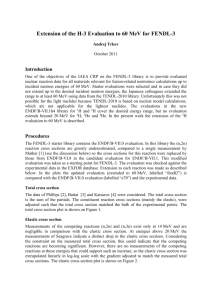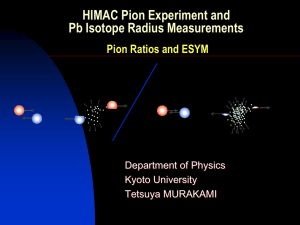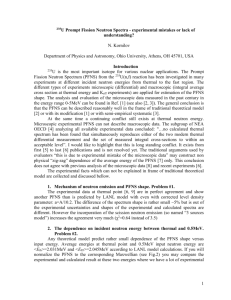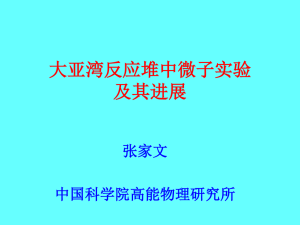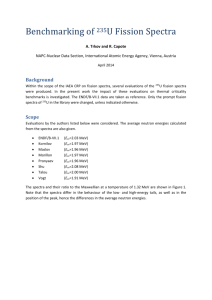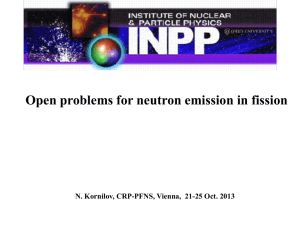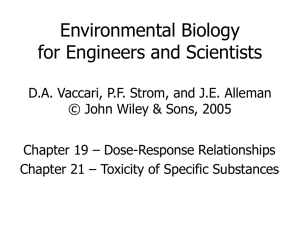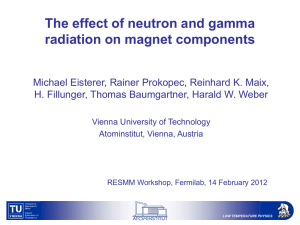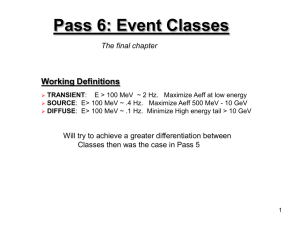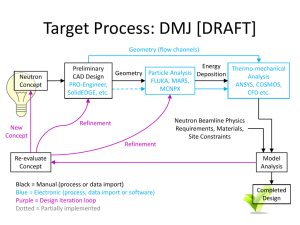235U Prompt Fission Neutron Spectra - Conflict of the - CEA-Irfu
advertisement
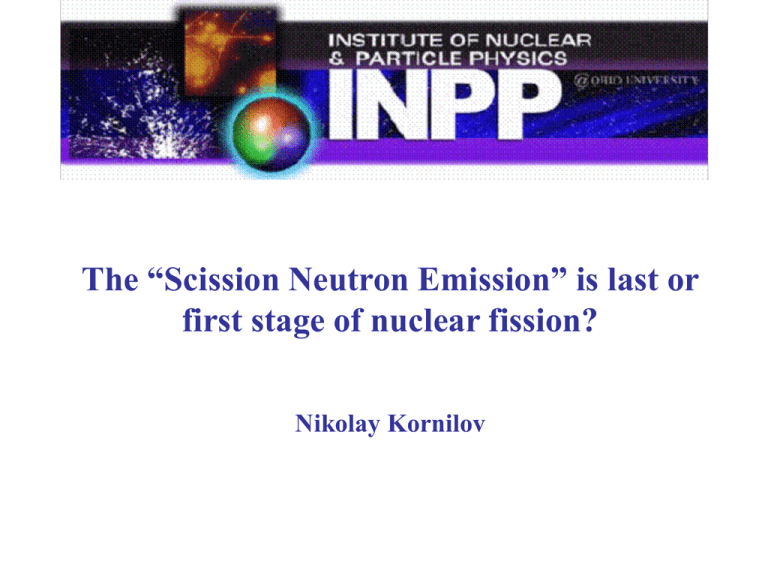
The “Scission Neutron Emission” is last or first stage of nuclear fission? Nikolay Kornilov Experiments • Microscopic (differential) experiments (as a rule TOF) • Macroscopic experiments • Integral experiments Direct neutron beam 235U Neutron detector Thermal neutrons IC with 235U M=0.2mg-10g Activated samples N ( E ) ( E ) dE Pulsed neutron beam with energy Eo Neutron detector Bulk sample, M~100g • Benchmark experiments Keff= 1 ± β IRMM-2007 Problem during more than 50 years of the experimental efforts! • 1972, Islam and Knitter motivated new experiment "…though the results of the above measurements, characterized by the average fission neutron energy, <E>, agree reasonably with each other, a number of integral experiments shows higher values for <E> indicating a harder fission neutron spectrum than that given by differential measurements". • 2003, Madland "…no calculated thermal spectrum has been found that simultaneously reproduces either of the two modern thermal differential measurement and the set of measured integral cross-sections to within an acceptable level” • PFNS from microscopic experiments at thermal energy do not agree with integral data and can not reproduce Keff for benchmark experiments ENDF/B-7 235 U: AVERAGE ENERGY OF FISSION NEUTRONS 2.2 evaluation 1999 (Kornilov et al) evaluation 2004 (ENDF/B-7) average for Eth (exp I) IPPE+RI; 1990-95 (exp I) Johansson, 1977 (exp II) evaluation 2002 (Hambsch et al) <E>, MeV 2.1 2.0 Keff=1 ???????? 1.9 0 1 2 3 4 5 INCIDENT NEUTRON ENERGY, MeV Available differential data 235U • Thermal point: Starostov et al (1983), 3 spectra, Lajtai et al (1985), Yufeng et al (1989), Kornilov et al (2008), 3 spectra; • 0.5 MeV: Trufanov (1994), Staples (1995), IRMM (2006-08) 8 spectra; • 1-5MeV: Boykov (1991, 2.9 MeV), Trufanov (1994, 5MeV), Staples (1995, 1.5, 2.5, 3.0MeV) Sources of information 1.6 1 1.4 R() N(E,) 1.5 1.3 1.2 1.1 0 1.0 2 4 1,0 eV M E, 6 0,5 8 0,0 10 -0,5 12 -1,0 0.9 0.0 0.2 0.4 0.6 0.8 1.0 0.20 0.7 0.18 0.6 0.16 0.5 Yscn(),1/d Yscn(), 1/d Angular distribution of SCN relative to FF 0.14 0.12 0.10 0.4 0.3 0.2 0.08 0.1 0.06 0.0 -1.0 0.04 -1.0 -0.5 0.0 0.5 1.0 E1-E2=0.5 - 6 MeV -0.5 0.0 0.5 1.0 Energy spectrum of SCN in LS Yscn(E), 1/MeV 0.1 0.01 1E-3 0 2 4 6 E, MeV 8 10 Non “direct” method for SCN estimation • Shape of the PFNS at thermal point requires the SCN incorporation (problem #1). R(E), <E>=1.988MeV 1.2 1.0 0.8 Starostov, 1982 IRMM, 2008 LANL, a=A/10.2 0.6 χ2=3.5 0 2 4 6 E (MeV) 8 10 12 3 sources model In case of SCN emission, the resulting spectrum is composed of three sources (3 sources model): N ( E ) N A1 ( E ) N A ( E ) N SCN ( E ) (1) 1. Neutrons from fragments after fission of the compound nucleus A+1 N A 1 ( E ) (1 ) WA 1 ( E ) (2) where α is the share of scission neutrons and WA+1 is the spectrum which describes the neutron emission from accelerated fragments; 2. Neutrons from accelerated fragments after fission of the nucleus A, which is formed due to the emission of one SCN: N A ( E ) ( 1) W A ( E ) / . (3) 3. Scission neutrons themselves: N scn ( E ) E E exp 2 T T 1 1 1 E T 2 exp T 2 2 , (4) where ω is the share of the low energy component and is the neutron multiplicity. “3 sources model” spectrum and thermal data R(E), <E>=1.988MeV 1.4 this work eq. 1 eq. 2 eq. 3 eq. 4 1.2 1.0 0.8 0.6 The residual chi-square is χ2=0.64 0.4 0.2 0.0 0 2 4 6 E (MeV) 8 10 12 Experimental results for 235U and 252Cf Parameter , 1/f 1 T1, МэV T2, МэV <E>, МэV 252 Cf, Bowman, 1962 0.460.02 0.410.03 0.350.04 1.770.07 2.380.13 252 Cf, BudtzJorgensen, 1988 0.3820.003 0.6790.012 0.4780.008 1.540.04 1.640.04 235 U Skarsvag, 1963 0.3780.006 0.6570.041 0.490.02 1.370.07 1.580.09 235 U IRMM-2008 0.41 0.26 0.34 1.31 2.12 Vorob’ev (2007) et al estimated ~ 10% for 235U at thermal point What is happened at 0.5MeV? • The difference of the PFNS shape between thermal and 0.5 MeV input energy can not be predicted with existing theoretical model (problem #2). • • <Eth> = 2.031MeV ; <E05> = 2.045MeV IRMM(th) (2008) and Johansson (1977) 0.5MeV data 1.2 R(E), <E>=1.988MeV 1.4 R(E) 1.0 E0=thermal 0.8 E0=0.5MeV 0.6 Johansson IRMM ENDF/B-VII, a=A/11 1.2 1.0 0.8 0.6 0 2 4 6 E (MeV) 8 10 12 0 2 4 6 E (MeV) 8 10 12 What is happened at 0.5MeV (cont)? 1.2 b) R(E) 1.0 0.8 IRMM, 2006, 0.5MeV Staples, 1995, 0.5MeV ENDF/B-7, a=A/11 IRMM, 2008, thermal IRMM, 2007, 0.5MeV 0.6 0 2 4 6 E (MeV) 8 10 12 What does mean angular effect? • Problem #3 R(E), <E>=2.002MeV 1.2 1.1 1.0 Jan08-R90 Jan08-L90 Jan08-R150 Apr07-R90 Apr07-L120 Apr07-R150 Jul06-R90 Jul06-L120 ENDF/B-VII 0.9 0.8 0.7 0 2 4 6 E (MeV) 8 10 What does mean left-right asymmetry? Average spectral ratios <R> = N(E,R90)/N(E,L90) Monitor and their uncertainty for different energy intervals. Pb bar Sample Pb bar E1-E2, MeV 0.8 -2 2-3 3-4 4-5 Detector 1 Detector 2 Proton beam <R>±δR <R>±δR E1-E2, MeV 0.999±0.003 5 – 6 1.010±0.002 6 – 8 1.020±0.005 8 – 10 1.034±0.004 1.009±0.005 1.051±0.006 0.970±0.032 Detector 3 1.10 L03 000 R03 R90/L90 1.05 1.00 0.95 0.90 2 4 6 E (MeV) 8 10 Angular effect can be reproduced…. R(E), <E>=2.002MeV 1.2 =0.0 1.0 =0.45 0.8 0.6 0 2 4 6 8 10 12 E (MeV) WHY share of SCN is changing……???? There is NO any idea to explain the difference between differential and integral data! (problem#4) 1.2 IRMM-2008 Lajtai Starostov 3 source model ENDF/B-VII 1.2 ENDF/B-VII experimental PFNS, eq. 1 1.1 R(E)=C/E R(E), <E>=1.988MeV 1.4 1.0 0.8 1.0 0.9 0.6 0.8 0.01 0.1 1 E (MeV) 10 0 2 4 6 8 <E> (MeV) 10 12 14 Integral data Ratio of the calculated average cross sections to experimental data for 252Cf [Mannhart], and 235U with the ENDF/B-VII and “3 sources model” neutron spectra. The ratio uncertainties δR include only experimental errors. 252 Reaction 235 Cf ENDF/B-VII 19 F(n,2n) Al(n,p) 46 Ti(n,p) 48 Ti(n,p) 51 V(n,α) 56 Fe(n,p) 59 Co(n,α) 58 Ni(n,p) 63 Cu(n,α) 90 Zr(n,2n) 93 Nb(n,n’) 93 Nb(n,2n) 115 In(n,n’) 204 Pb(n,n’) 235 U(n,f) 238 U(n,f) 237 Np(n,f) <R>±σ/(N-1)1/2 27 <E>, MeV 14.37 6.32 6.37 8.76 10.38 7.99 8.70 4.52 7.61 14.70 3.01 11.69 3.05 5.42 2.13 3.32 2.51 R±δR 1.009±0.033 1.005±0.022 0.982±0.018 1.003±0.019 0.987±0.022 0.998±0.018 0.996±0.019 0.998±0.013 1.005±0.020 0.991±0.029 0.989±0.017 1.027±0.051 0.970±0.017 0.974±0.057 1.006±0.012 0.979±0.016 0.999±0.016 0.995±0.004 <E>, MeV 14.08 6.11 6.16 8.45 10.03 7.74 8.40 4.35 7.33 14.49 2.90 11.49 2.93 5.23 2.03 3.16 2.39 R±δR 1.019±0.139 0.989±0.018 0.994±0.017 0.997±0.066 1.005±0.023 0.973±0.062 1.012±0.022 0.992±0.013 1.006±0.048 1.108±0.076 0.972±0.047 0.964±0.049 1.001±0.012 0.940±0.106 1.013±0.019 0.994±0.023 0.998±0.021 0.998±0.009 N ( E ) ( E )dE, E 1 E N ( E ) ( E ) dE U Experimental PFNS, eq.1 <E>, R±δR MeV 14.03 0.868±0.139 6.07 0.941±0.018 6.12 0.948±0.017 8.41 0.927±0.066 9.97 0.915±0.023 7.70 0.913±0.062 8.35 0.942±0.022 4.33 0.959±0.013 7.28 0.948±0.048 14.45 0.937±0.076 2.88 0.951±0.047 11.45 0.860±0.049 2.91 0.977±0.012 5.20 0.903±0.106 1.99 1.013±0.019 3.14 0.968±0.023 2.36 0.985±0.021 0.938±0.010 Possible explanation ? • • • • • • One may conclude that a factor exists which has a rather strong influence on the PFNS shape and asymmetry effects but was not fixed in experimental investigations at 0.5MeV input neutron energy All experiments which results were used in the report were made with 7Li(p,n) reaction as a neutron source and pulsed mode. One may assume that this factor is the neutron polarization. We should take into account the possible proton polarization also due to pulsed mode of the accelerators (chopper, bunching high voltages, analyzing and switching magnets). In the preparation stage of any PFNS experiment it was assumed that this factor is not important or by definition should be equal to zero. If this explanation is true, the transmission mechanism of the information from the incident neutron to the secondary fission neutron should be found. The only possibility might be scission neutron emission, a fast process without formation of the compound nucleus. This may provide the link between the incident neutron and the secondary fission neutron. So, for real clarification of this effect we need new experiments with polarized thermal neutron beam. When we will confirm and verify this effect new theoretical model should be developed. The most difficult for understanding is the problem #4. There are not any realistic ideas for its solving. May be they will come after new experimental efforts mentioned above. Neutron decay from excited states in the second minimum? Bni Bn0 Conclusion • New experimental and theoretical efforts are necessary to answer the following very important questions: • what is the mechanism of neutron emission in fission and fission process itself. ~40% of fission should be happened without COMPOUND nucleus formation; • why the shape of the prompt fission neutron spectrum may change so drastically. Thermal-0.5 MeV data, angular effect. SC Neutrons should be emitted at beginning stage of fission, in any case, the low energy component. We should construct the mechanism; • what is the physical reason responsible for the formation of a more energetic spectrum in the integral experiments in comparison with microscopic data, and • what is happening inside nuclear reactors. Team • F.-J. Hambsch, I. Fabry, S. Oberstedt EC-JRC-Institute for Reference Materials and Measurements, Retieseweg 111, B-2440 Geel, Belgium • T. Belgya, Z. Kis , L. Szentmiklosi Institute of Isotopes HAS, Dept. of Nuclear Research, Budapest, Hungary • S. Simakov Forschungszentrum Karlsruhe, Institut für Neutronenphysik und Reaktortechnik, D-76344 Eggenstein-Leopoldshafen, Germany
